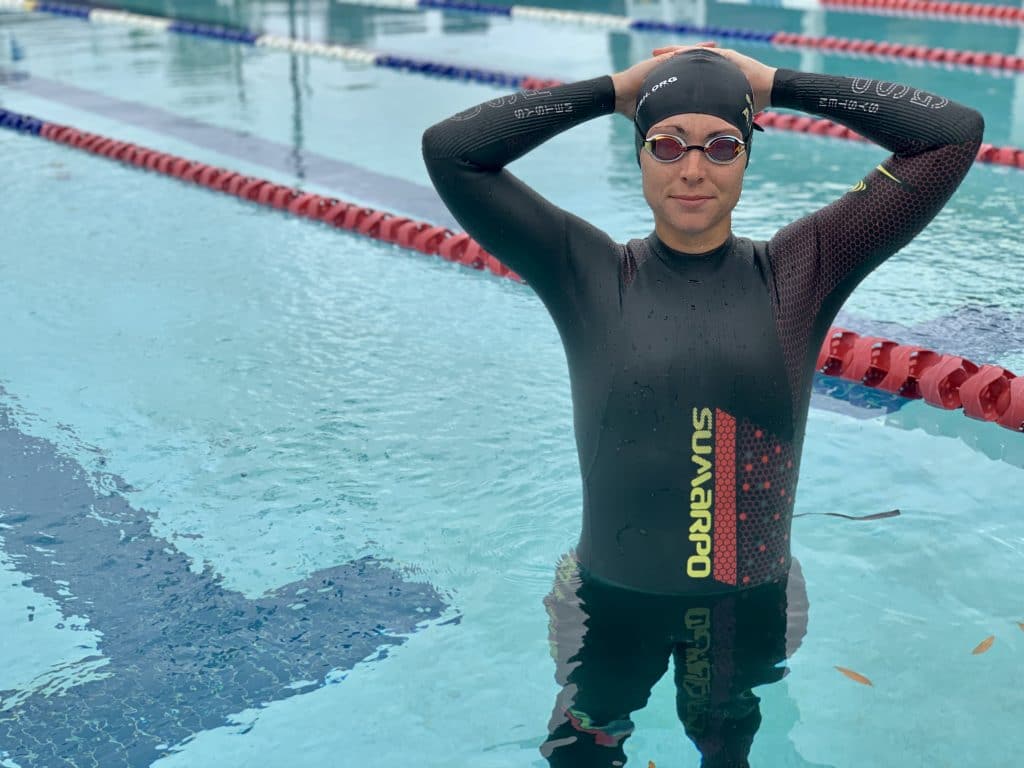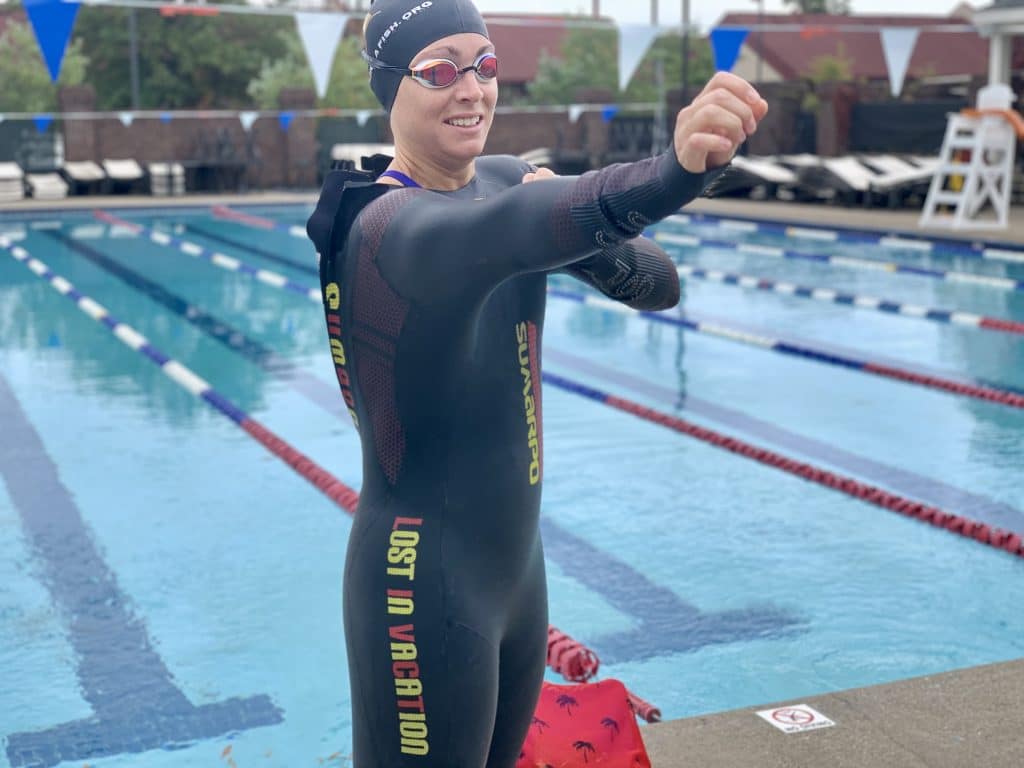Anyone who is considering open water swimming – whether as part of triathlon training, an open water swim event, or simply giving swim training a different angle – has probably thought about using a wetsuit, and for very good reason.
Wetsuits provide swimmers with some creature comforts and perhaps an advantage or two, and there are definitely times when using a wetsuit is wise.
When to Consider a Wetsuit?
There are a few times when using a wetsuit is a smart move for the open water swimmer. A few of the more common situations where wetsuits are often recommended are:
- When the water will be cold. Generally speaking, anytime the water temp is below 70 degrees, a wetsuit can feel pretty good. And anytime the water temp is below 65, a wetsuit might actually be advised in order to keep the swimmer from having a reaction to the cold. For reference, the typical lap pool is about 78 degrees or even up to the low 80s, so running into water that is 62 degrees can be a rude awakening, and can also zap your energy as your body works to keep you warm.
- When confidence is an issue. A wetsuit adds a slight bit of buoyancy to your body, making it feel a bit like a safety blanket. This can be nice if you are not as confident in open water as you are in the pool. We talk with many athletes who are very good pool swimmers, but uncomfortable in open water, and a wetsuit gives them a psychological safety net.
- When it is a long open water swim. A wetsuit can actually help your body positioning given its buoyancy assist, which in turn can help you become less fatigued during a long swim.
For swimmers doing shorter swims (for which the definition is a little different for everyone) in more comfortable temps, wetsuits are optional. In a triathlon, for example, weight the gain you will get from using a wetsuit with the additional time it will take to remove it at Transition 1.
What Kind of Wetsuit to Consider?

An important thing to know about wetsuits is that there are several different types, made for several different situations. Open water swimmers want a wetsuit made for athletes – like the wetsuits profiled here — not a wetsuit that was designed for surfers or snorkelers.
The best open water swimming wetsuits are made by triathlon and swim gear makers, like Xterra, Orca, or Blueseventy. The wetsuits made for recreational and boating use typically do not have the range-of-motion needed for swimming hard in open water, they are made more for simply keeping people warm, and as a result can actually be difficult to swim in.
Most manufacturers of good athletically-geared wetsuits have different neoprene thicknesses on the wetsuit specs – 2mm, 4mm, 5mm, etc. Typically, the thicker the wetsuit, the warmer it will be… but you also want lots of “paneling” so you can move around well. The core of the wetsuit might be 5mm, but the shoulders should be thinner so you can move freely with your swim stroke, such as 2mm.
This “paneling” is what is missing on recreational wetsuits, but it is what allows a more athletic wetsuit to be comfortable to swim in. Given that most open water swimmers will be doing the Freestyle stroke, having ample range-of-motion in the shoulders is critical.
How to Get Comfortable in a Wetsuit?

Wetsuits are supposed to be tight, which for some people is a sensation that requires some getting used to. The snug feeling of a wetsuit can feel constricting the first time you use it.
One thing you will notice when you practice with a wetsuit is that it can sometimes be a challenge just to put on! Getting a wetsuit on is not always a simple task. Go slowly as you slip into the suit — the new formfitting and super-slim models can tear if you stab the material with your finger or toenail. Pull the wetsuit on with your finger pads and don’t use your fingertips and nails.
Always put a wetsuit on while you are dry, as putting a wetsuit on wet skin is more difficult. If you need a couple tips for getting your legs through the stubborn leg holes, we have known people to keep their socks on for better sliding ability, or to actually put plastic bread bags over their feet while they push their legs through! Just remember, go slow, be gentle, and try not to rip the neoprene.
When you are ready to begin swimming, it is good to start slowly, not throwing yourself into an ultra-long swim your first time out. If you plan to use the wetsuit for a race or event, definitely practice in it to get a feel for it before the big event. This will allow you to not only get used to the wetsuit, but you can also practice things like sighting that you would not need to do in a pool.
When you go for a practice swim, you may get the illusion of moving more slowly in the water, but don’t mind that. You are probably actually moving faster than you would without the suit, but the sensations of water moving along your body are muted.
We mentioned that in addition to keeping you warmer, a wetsuit will also assist your buoyancy. One interesting effect of this aided buoyancy is that you might find you don’t need to kick as much or as hard. Don’t let the wetsuit cause you to stop kicking though! The kick is still important for body positioning, is key to your propulsion, and can help stabilize your body if you are doing your open water swim on a windy or wavy day. If you’re looking for more detailed coaching on how to swim FASTER with a wetsuit on, be sure to check out SLAF’s virtual coaching packages here.
Some triathletes use a sleeveless wetsuit, others use a full-sleeved version. It is really a matter of personal preference. The full-sleeve wetsuit will be warmer and a bit more buoyant, while some triathletes and open water swimmers prefer a sleeveless version for the improved range-of-motion a bit more freedom in the shoulders and arms. Either way, be sure you get a quality wetsuit that is made for athletes, not for recreation or boating, as we noted before.
Conclusion:
Using a wetsuit can be a really smart move in the right situations, especially when you will be swimming in super cold water, will be swimming a long distance, or simply need the added comfort and buoyancy of the wetsuit. Whatever you decide to do, we always recommend practicing your wetsuit before any big event or race. Get used to your wetsuit, invest in one that works for your budget and your needs, and you will quickly find that the wetsuit becomes a key part of your triathlon checklist.

One Response
Excellent 👌👌👌